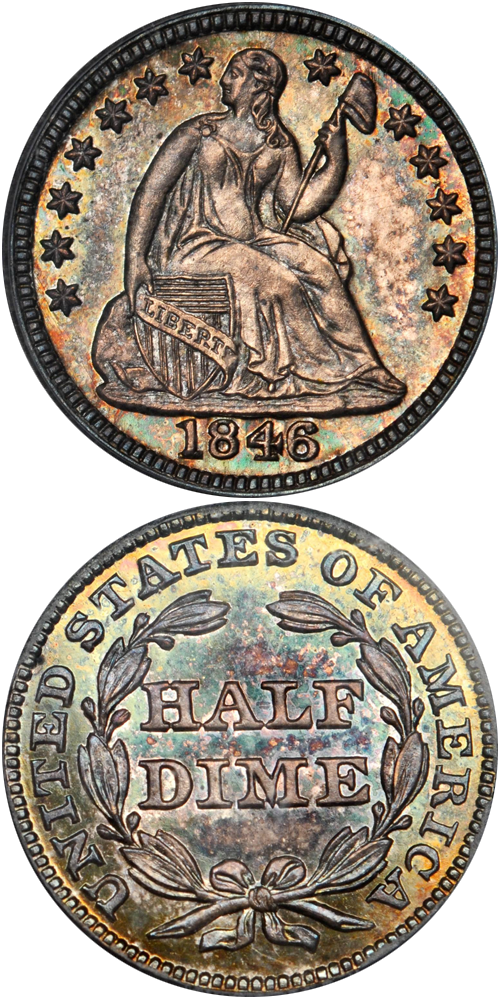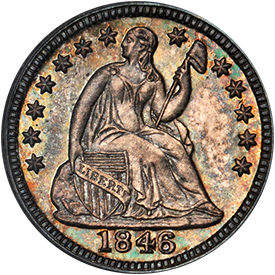Designed by: Christian Gobrecht
Issue Dates: 1838-1853, 1856-1859
Composition: 90% silver, 10% copper
Diameter: 15.5 mm
Weight: 1.33 grams (20.62 grains, 1838 to 1853), 1.24 grams (19.2 grains, 1856 to 1859)
Edge: Reeded
Business Strike Mintage: 42,705,774
Proof Mintage: Fewer than 1,500 pieces
In 1838 stars were added to the obverse of the Liberty Seated design. Otherwise, the motif is similar to the 1837 and 1838-0 Liberty Seated pieces. From 1838 through 1859 many different varieties were produced, including some struck at the New Orleans Mint (and bearing a distinctive O mintmark on the reverse). Early issues lack drapery at Miss Liberty's elbow.
There are some scarce dates and varieties within the range, notably 1846, 1849-0, and 1853-0 without arrows at date, but there are enough common varieties that it is not difficult to acquire an example in Good to Very Fine preservation at reasonable cost. Extremely Fine coins abound, and AU examples can be obtained easily. Uncirculated pieces are scarce, and higher echelon Uncirculated coins are scarcer yet.
Although the general Liberty Seated type with obverse stars was minted from 1838 through 1859, certain specimens of 1853 and all of those dated 1854 and 1855 were produced with arrowheads at the date and represent a distinctive type.
Further Reading
The Liberty Seated design was modified in 1838. A semicircle of 13 stars was added around the obverse border. This general design was used in the half dime series from 1838 through 1859.
Early pieces in the series lack drapery at Miss Liberty's elbow. Mint officials decided that this was an oversight and agreed that the addition of drapery would make Miss Liberty's dress more flowing in appearance. So, this feature became a part of all denominations featuring the Liberty Seated design. The proportional size of the drapery differed vastly from one series to another. On the half dimes of 1840 the drapery is very large. On Liberty Seated half dollars it is very small in proportion.
From 1838 through 1853 Liberty Seated half dimes were produced at the Philadelphia and New Orleans mints. The New Orleans issues bear distinctive O mintmarks.
Many varieties of half dimes occur throughout the 1837-1873 period, including the 1849/6 and 1849/8 overdates. A number of pieces are elusive, 1846 being the most prominent Philadelphia Mint date in this regard. In general, New Orleans half dimes of this period are quite rare in Uncirculated grade. These have been grossly undervalued and unappreciated over the years. The 1849-O half dime is elusive in all conditions, and a Choice Uncirculated coin, if one ever appears on the auction market, would be a cause for celebration among half dime specialists!
In 1856 the arrows were discontinued. The earlier design was resumed from that point until 1859. The 1856-1859 span includes two interesting varieties, one of which is very rare. The first is the seldom seen 1858 half dime with regular date over inverted date. The engraver first cut the entire date 1858 upside-down. Realizing his error, he then punched the date in its correct position. A magnifying glass clearly shows both sets of numerals. This issue is scarce in all grades and is a major rarity in Uncirculated preservation.
The second interesting variety is the 1859 Philadelphia Mint half dime with stars having hollow center points. All 1859 half dimes have this feature. What constitutes a "type" and what doesn't is a matter of opinion. While tradition has not dictated that the 1859 half dime be isolated as a specific piece needed for type sets, still it is interesting and distinctive.
In 1859 and 1860 two transitional pattern half dime varieties were made. Each of these is interesting inasmuch as the term UNITED STATES OF AMERICA does not appear on either. The obverse of each features the Liberty Seated design with stars surrounding. The reverse features the notation HALF DIME surrounded by a wreath. The 1859 issue is extremely rare, and often a period of years will pass between auction offerings. The 1860 transitional pattern half dime was minted to the extent of 100 pieces, according to a personal notebook kept by James Ross Snowden, Mint director at the time. This mintage figure should probably be taken with a grain of salt, for my firm has had nearly this many over the years, and other firms have handled additional pieces. In 1973, when writing an article on this issue, I noted that as of that time we had handled approximately 50 pieces, and since that time more have gone through our hands. Specimens of this issue were struck with frosty "Uncirculated" surfaces, rather than Proof finish, an unusual situation for a pattern. When encountered, specimens of the 1860 transitional are apt to be in frosty, Choice Uncirculated grade. I have never seen one with even a slight degree of wear.








